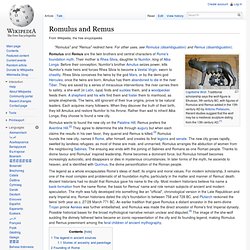

Romulus and Remus. Capitoline Wolf.

Traditional scholarship says the wolf-figure is Etruscan, 5th century BC, with figures of Romulus and Remus added in the 15th century AD by Antonio Pollaiuolo. Recent studies suggest that the wolf may be a medieval sculpture dating from the 13th century AD.[1] Romulus wants to found the new city on the Palatine Hill; Remus prefers the Aventine Hill.[2] They agree to determine the site through augury but when each claims the results in his own favor, they quarrel and Remus is killed.[3] Romulus founds the new city, names it Rome, after himself, and creates its first legions and senate. The new city grows rapidly, swelled by landless refugees; as most of these are male, and unmarried, Romulus arranges the abduction of women from the neighboring Sabines.
The ensuing war ends with the joining of Sabines and Romans as one Roman people. The legend as a whole encapsulates Rome's ideas of itself, its origins and moral values. The legend in ancient sources[edit] Castor and Pollux. Dioscuri (Pollux or Castor), Rome, Capitol Dioscuri (Castor or Pollux), Rome, Capitol They are sometimes called the Tyndaridae or Tyndarids,[7] later seen as a reference to their father and stepfather Tyndareus.

Birth and functions[edit] Castor depicted on a calyx krater of ca. 460–450 BC, holding a horse's reins and spears and wearing a pilos-style helmet Castor and Polydeuces are sometimes both mortal, sometimes both divine. The Dioscuri were regarded as helpers of mankind and held to be patrons of travellers and of sailors in particular, who invoked them to seek favourable winds.[9] Their role as horsemen and boxers also led to them being regarded as the patrons of athletes and athletic contests.[10] They characteristically intervened at the moment of crisis, aiding those who honoured or trusted them.[11] Classical sources[edit] Pair of Roman statuettes (3rd century AD) depicting the Dioscuri as horsemen, with their characteristic skullcaps (Metropolitan Museum of Art) Mythology[edit] Trade. A trader in Germany, 16th century Trade exists for man due to specialization and division of labor, in which most people concentrate on a small aspect of production, trading for other products.

Trade exists between regions because different regions have a comparative advantage in the production of some tradable commodity, or because different regions size allows for the benefits of mass production. As such, trade at market prices between locations benefits both locations. Trading is a value added function of the economic process of a product finding its market, where specific risks are to be borne by the trader, affecting the assets being traded which will be mitigated by performing specific functions. History[edit] Prehistory[edit] In the mediterranean region the earliest contact between cultures were of members of the species homo sapiens principally using the Danube river, at a time beginning 35-30,000 BC.[4][5][6] Ancient history[edit] Obsidian[edit] New Guinea[edit] Lapis Lazuli[edit] Writing. Writing with a pen Writing is a medium of communication that represents language through the inscription of signs and symbols.

In most languages, writing is a complement to speech or spoken language. Writing is not a language but a form of technology. Within a language system, writing relies on many of the same structures as speech, such as vocabulary, grammar and semantics, with the added dependency of a system of signs or symbols, usually in the form of a formal alphabet. The result of writing is generally called text, and the recipient of text is called a reader. As human societies emerged, the development of writing was driven by pragmatic exigencies such as exchanging information, maintaining financial accounts, codifying laws and recording history.
Means for recording information[edit] H.G. Writing systems[edit] The major writing systems – methods of inscription – broadly fall into four categories: logographic, syllabic, alphabetic, and featural. Logographies[edit] Syllabaries[edit]